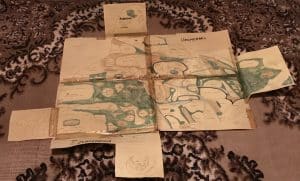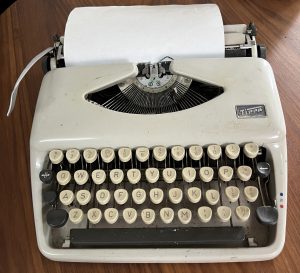Typewriter Mania
I have no idea how long my handwritten novel is.
One A5 exercise book is 240 pages. I average about fifteen words a line, and there’s twenty-five lines per page. That would mean there’s roughly 90,000 words in that book. I made it halfway through the second exercise book, which would make that first draft (not counting the annotated material) about 135,000 words.
Given how scrappy it was, given the notes scribbled on inside covers, given it had taken writing a book to work out the story, I knew I had to rewrite it from word one (even if you could do something with a hideously handwritten novel).
Moving up in the world, I bought an A4 exercise book, and commenced rewriting now that I had a firmer understanding of my universe, the story, and the characters. But about one-hundred pages in, I grew frustrated with my handwriting not being able to keep up with the narrative streaming from my imagination. Also, it felt redundant, handwriting it again. I’d done that. I wanted to evolve.
My home computer, the Commodore 64, was not built to be a word processor, although it had a couple of crappy word processing programs. This was also still a few years before PCs began making their way into homes with the same ubiquity as toasters.
I found a typewriter store a couple of suburbs down, and bought a second-hand manual typewriter – a clunker with a lovely feel to the keyboard. When you type, the right feel of the keyboard under your fingertips is pivotal.
Writing on a typewriter was liberating – no needing to wait for slow hands to translate manic thoughts (as much as some like that, but not for me). And there was something to seeing each letter imprinted on a page, each word forming, each sentence building, each page filling.

I also drew a map of my fantasy land, Eldoraenia, scribbling it on various sheets of A4, taping them together, then sticking it on the wall above my writing desk (a cannibalized kitchen table) in the bungalow my brother had converted one quarter of the garage into. The map immediately informed every situation the characters faced. Whenever I run workshops, I always advise anybody writing fantasy to draw up a map.
There were false starts, as well as self-contained scenes, and the occasional short story I wrote, banging away feverishly on the typewriter, sometimes sitting there for twelve-hour sessions I enjoyed it so much.
Something pivotal that occurred around this time was that I read David Eddings’s five-book fantasy series The Belgariad, which I loved, and which also taught me that fantasy didn’t have to be all stiff formality, that it could be conversational. Seeing that, learning that, revolutionized how I approached writing. The dense, flowery prose (me clumsily trying to emulate Tolkien) was out. Learning to be me (on the page) was in.

The only problem I faced months and months later was the second-hand typewriter developing an issue with the carriage, which meant I had to buy a new manual typewriter. I didn’t like the feel of the keys as much on this one, and the letters (as they appeared on the page) were bigger, so I couldn’t just continue the existing draft.
I had to start over.
I banged out the opening one-hundred pages several times, often changing the supporting characters.
Interestingly, the same handful of main characters remained through every draft, although their backstories changed. But I kept searching for the right balance of supporting characters. If I didn’t have them, if I didn’t have the right foundation, then I couldn’t keep building.
All these restarts provided a valuable education. They taught me that I needed to have a good idea behind the story. I didn’t need to know everything, but enough to drive the narrative. From a purely pragmatic standpoint, I also learned to persevere.
When I finally worked out who my characters were, I wrote and wrote and wrote.
And wrote.
When I wasn’t writing on the typewriter, I dedicated notebooks to monarchies, timelines, shitty languages I created (based entirely on letter substitutions, rather than any genuine linguistic understanding), and whatever else helped develop my world.
In my head, I worked out this would be a four-book series, there would be a five-book sequel, and then there’d be a three-book prequel (and, this time, I actually knew what the stories would be for each series).
It was epic madness, fused into passion, and fueled by my usual mania.
Eventually, I completed what I guess would be considered a second draft – no idea on the word count, but it amounted to 400 A4 pages.
But not long after, my mental health stuff blew up spectacularly.